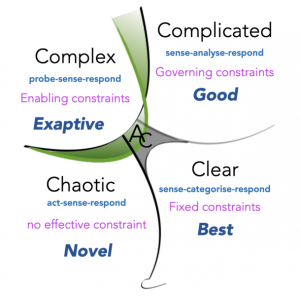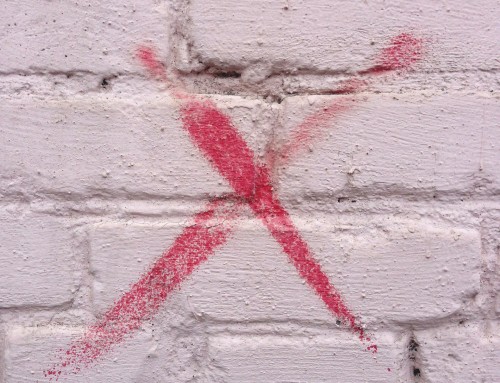The Cynefin Framework
Aspects of Complexity
The Cambridge Dictionary defines Complexity as "...the state of having many parts and being difficult to understand or find an answer to". Wikipedia characterizes Complexity as "the behaviour of a system or model whose components interact in multiple ways and follow local rules, leading to nonlinearity, randomness, collective dynamics, hierarchy, and emergence."
These days, VUCA (uncertainty, volatility, complexity, and ambiguity) is a cliche in decision-making. The business world is volatile, uncertain, complex and ambiguous. The markets and financial world is. Technology and innovation anyway. However, "complexity is everywhere, but not everything is complex" (Martin, Ponton, Ballestrin 2022).
The Cynefin framework, created by David Snowden in 1999 when he worked for IBM Global Services, is a framework for sensemaking when finding decisions. It can be used as a guideline to identify the levels of certainty in the environment. It gives advice to classify how we perceive situations and make sense of our own and other people's behaviour. It Cynefin, pronounced /kəˈnɛvɪn/ kuh-NEV-in, is Welsh for a “place of your multiple belongings”. The name signifies the multiple, intertwined factors in our environment and our experience that influence us (how we think, interpret and act) in ways we can never fully understand (Snowden 2023a).
The framework draws on research into systems theory, complexity theory, network theory and learning theories.
The model consists of five domains: clear (known as simple until 2014, then known as obvious until recently renamed), and domains complicated, complex, chaotic, and aporetic/confusion (in earlier versions of the framework, this domain was called disordered).
-
The Clear domain is characterized by stability, rules in place (or best practices), and cause-and-effect relationships clear to everyone. The right answer is self-evident. It represents the "Known knowns".
To react in such a situation is to "sense – categorize – respond":
-
- establish the facts ("sense"),
- categorize them,
- then respond by following the rule or applying best practices.
- The Complicated domain may contain multiple right answers. Although there is a clear cause-and-effect relationship, not everyone can see it. Decisioning requires analysis or expertise (subject matter experts) since there is a range of right answers. This is the field of “Known unknowns”.
To react in such a situation is "sense – analyze – respond":
-
- assess the facts,
- analyze them, and
- apply the appropriate good operating practice.
- The Complex domain represents the "Unknown unknowns". We cannot predict the outcome. Instead, we need to influence our decision-making with an exploratory approach to running experiments. In this environment, cause and effect can only be deduced retrospectively with a test-and-learn approach. And there are no right answers, we have to cope with partial correctness and its ensuing ambiguity.
"In a complex context, right answers can’t be ferreted out at all; rather, instructive patterns emerge if the leader conducts experiments that can safely fail. This is the realm of “unknown unknowns,” where much of contemporary business operates. Leaders in this context need to probe first, then sense, and then respond." (Snowden, Boone 2007).
To react in a complex context we need to
-
- probe first,
- then sense, and then
- respond.
- In the Chaotic domain, cause and effect are unclear. It is the realm of the “Unknowable”. The relationships between cause and effect are impossible to determine because they shift constantly and no manageable patterns exist. It is futile to search for the right answers. Decisions are required very fast. Action — any action — is the first and only way to respond appropriately. The main aim is to control the environment and prevent further bad things from happening.
In this context, we should apply the pattern "act–sense–respond".
-
- act to establish order;
- sense where stability lies;
- respond to turn Chaotic into Complex.
- The Confusion domain (the AC refers to Aporetic or Confusion) in the centre represents situations where there is no clarity about which of the other domains apply, "when we do not know where we are". By definition, it is hard to see when this domain applies. To react in this context is to break the situation into its constituent parts and assign each to one of the other four realms.
There is a clockwise drift from chaotic through complex and from complicated to clear the more knowledge we gain in specific situations. Similarly, there is a clockwise movement from simple to chaotic. Smugness and self-satisfaction cause a buildup of biases. On the contrary, when knowledge vanishes e.g. people die, knowledge is forgotten, or as new generations question the rules, there is a counter-clockwise movement. And a counter-clockwise push from chaotic to simple can occur when a lack of order causes rules to be imposed suddenly.
Further Reading
- Martin, Dave, Ponton, Tony, Ballestrin, Kim (2022): Decision Making in the Time of Complexity. Cutter Consortium, 2022. https://www.cutter.com/article/decision-making-time-complexity.
- Snowden, David (2023a): The Cynefin Co. https://thecynefin.co/about-us/about-cynefin-framework/.
- Snowden, David (2023b): Cynefin wiki. https://cynefin.io/wiki/Cynefin.
- Snowden, David J., Boone, Mary E. (2007): A Leader’s Framework for Decision Making. Harvard Business Review, HBR Nov. 2007. https://hbr.org/2007/11/a-leaders-framework-for-decision-making.
- Wikipedia: Cynefin Framework, https://en.wikipedia.org/wiki/Cynefin_framework.
: Massimo Virgilio via Unsplashcom • Cynefin Cynefin.io wiki, 2021, .








Leave A Comment